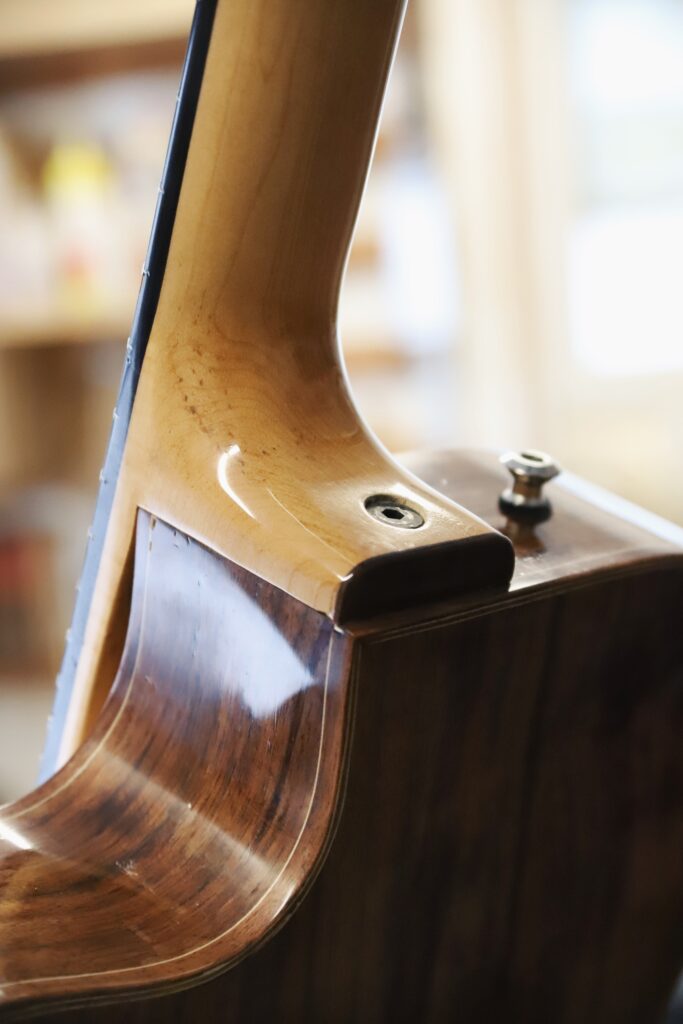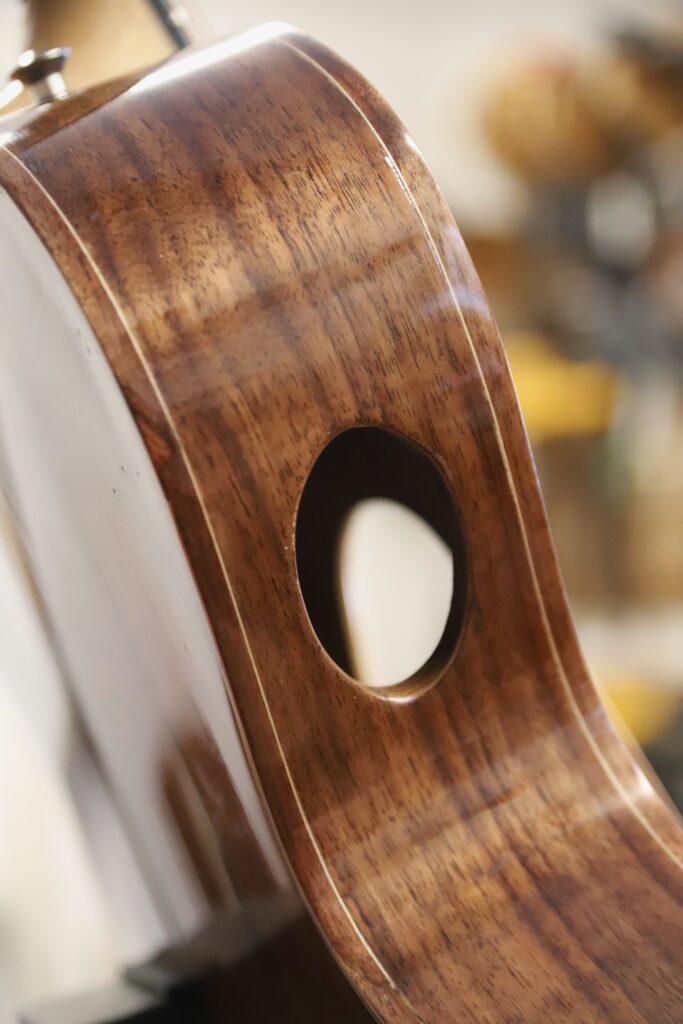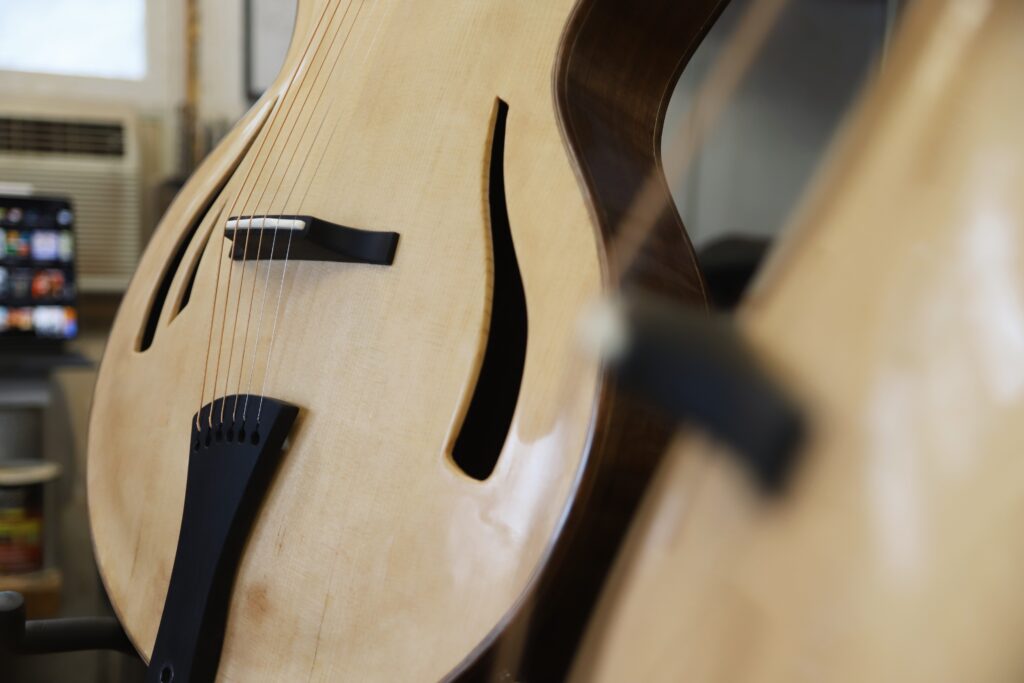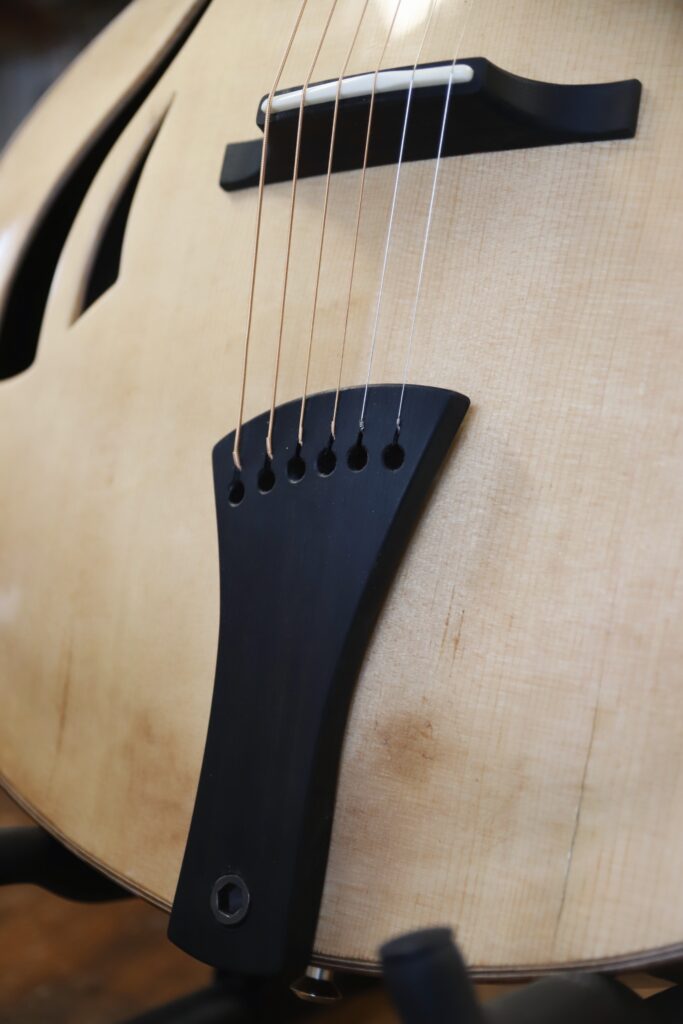An archtop guitar for the modern player
With it’s bold voice and robust solid wood construction, the Humboldt delivers a refined sonic palette in a package that stands up to the rigors of the working musician
The Archtop Experiment
As someone who enjoys building archtop guitars, an instrument that is often confined to jazz, my goal has long been to build an instrument that appeals to a broader genre of players. While the archtop does fit very nicely in a jazz setting, I wanted to create a guitar that is equally at home with a singer-songwriter, a country band, or in a bluegrass jam. This led me to this experiment: What if I built two nearly identical archtop guitars? Same design, same woods, same set up, as close to duplicates as my hands could get- with one variable changed. One would be closer to a conventional f-hole guitar, while the other would have an oval hole more reminiscent of a flat top acoustic. What effect would this have on the sound? To my ears, as you might expect, the f-hole model has a bit more punch and natural compression to the sound, where the oval hole sits somewhere between that classic archtop sound and something like a Jumbo flat top.
The interesting part? That is only my interpretation. These guitars always travel in pairs when I introduce them to new players, and I always ask which one they prefer. It is fascinating to me how it is always a different answer player to player. I personally prefer the oval hole for my playing, but sometimes when I hear someone else play the f-hole I actually prefer that sound. It has been incredibly rewarding to hear my guitars in the hands of many talented players.
Brian DiBiagio compares the two here: https://www.youtube.com/watch?v=h_rchIxubJA
Which one do you prefer?


Design Features
Reverse parallel bracing
I primarily used this bracing pattern to get the braces out of the way for the oval hole, but I found some other benefits to this pattern in my experimentation. Beyond bringing many of the same benefits of Taylor’s V-Class bracing to the archtop, the braces end up closer to each other under the bridge. I believe this adds a good bit of stability and strength to a high tension area, as well as allowing the top to resonate more freely, especially in the lower bout.
Bolt-on Neck Joint
You’ll notice many of these features are intended for the repair person. The easier a guitar is to repair, the longer it will stick around making music. This neck joint combines the mechanical connection of a traditional dovetail joint with the convenience of easily removing the neck with one external bolt. Neck angle adjustments are much easier and safer without having to introduce heat and moisture to the instrument.
Side port
Whenever I play the incredible guitars at the Artisan show in Harrisburg, I always seem to gravitate towards ones with a side port, so it just made sense to add it to my guitars as well. It acts as a monitor, shooting a portion of the sound directly to the players ear. I think it especially makes sense to have one on an archtop, which naturally are more directional. I also think it looks pretty cool with the thickness of the sides. Which is an excellent segue to…..
Structured Sides
You can tell from looking at the side port that my sides are substantially thicker than a normal acoustic. I laminated these sides with walnut outer layers and a kerfed cedar core. By constructing the sides this way, they gain an incredible amount of stiffness, which allows to the top and back to resonate more efficiently. The trade off is that it adds some weight, but using a lighter wood for the core and kerfing it helps a bit. Its also a nice benefit to have a nice cedar smell from inside the guitar!


Bridge
This is one of my favorite upgrades for these guitars. I’ve fought with archtop bridge designs for a while; it’s tough to balance effective energy transfer with ease of adjustment. I never really liked the idea of having two skinny threaded rods being the only thing transferring energy to the top. I much prefer to have a solid chunk of ebony doing that work. I upgraded my previous through slot to a blind slot, and added quite a bit of thickness to the saddle to allow for better intonation. By having a separate saddle, the action can be adjusted just as easily as a flat top acoustic.
Tailpiece
Same train of thought with the bolt-on neck, having a bolt for the tailpiece makes it more repair friendly, and holds it in place during string changes unlike a traditional tailpiece fastener. It also serves as a convenient way to ground the strings when using a magnetic pickup. You’ll notice one has the bolt exposed, and the other has an ebony plug to hide it. I couldn’t decide which I prefered, so I did one of each so I could compare. Which look do you prefer?
K&K Pure Archtop Pickup
I’ve installed plenty of K&K pure sound mini pickups in client’s flat top guitars and I love the sound, so it only made sense to put one of their pickups in these as well. I wanted them to be predominantly acoustic instruments, but still have the option to plug in if the situation requires. These are no nonsense pickups; no preamp, no battery, not even a volume control. Only the bare essentials of a pickup straight to the jack. I’m of the opinion that if there’s electronics that could be controlled by either an amp or a pedal on the floor, there’s no need for it to be inside the guitar weighing it down.
Both guitars are currently for sale, this page will be updated when they are sold. Please inquire by email to jordan@steelwoodworks.net if you are interested in purchasing, or if you’re simply interested in coming by and taking them for a spin! We would love to hear your input for the next batch.
Humboldt F-hole + Road Runner hard case – $2,500 SOLD!
Humboldt Oval hole + Road Runner hard case – $2,500
